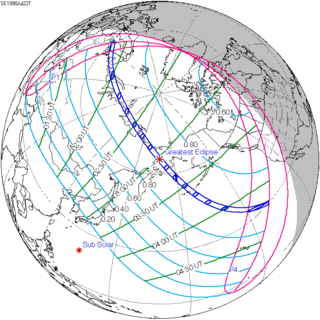| Solar eclipse of July 22, 1990 | |
|---|---|
 Partial from Finland | |
| Type of eclipse | |
| Nature | Total |
| Gamma | 0.7597 |
| Magnitude | 1.0391 |
| Maximum eclipse | |
| Duration | 153 s (2 min 33 s) |
| Coordinates | 65°12′N 168°54′E / 65.2°N 168.9°E |
| Max. width of band | 201 km (125 mi) |
| Times (UTC) | |
| Greatest eclipse | 3:03:07 |
| References | |
| Saros | 126 (46 of 72) |
| Catalog # (SE5000) | 9487 |
A total solar eclipse occurred at the Moon's descending node of orbit between Saturday, July 21 and Sunday, July 22, 1990,[1] with a magnitude of 1.0391. A solar eclipse occurs when the Moon passes between Earth and the Sun, thereby totally or partly obscuring the image of the Sun for a viewer on Earth. A total solar eclipse occurs when the Moon's apparent diameter is larger than the Sun's, blocking all direct sunlight, turning day into darkness. Totality occurs in a narrow path across Earth's surface, with the partial solar eclipse visible over a surrounding region thousands of kilometres wide. Occurring 2.7 days after perigee (on July 19, 1990, at 12:20 UTC), the Moon's apparent diameter was larger.[2]
Totality was visible in southern Finland including its capital city Helsinki, the Soviet Union (including today's northern Estonia and northern Russia), and eastern Andreanof Islands and Amukta of Alaska. A partial eclipse was visible for parts of Eastern Europe, North Asia, Alaska, western Canada, the western United States, and Hawaii.
In Finland, the solar eclipse occurred during sunrise and enabled observation and photography without protective glasses, which was however hampered by strong clouds.[3] The Sun was totally eclipsed in Helsinki began at 06:03:07 local time.
- ^ "July 22, 1990 Total Solar Eclipse". timeanddate. Retrieved 9 August 2024.
- ^ "Moon Distances for London, United Kingdom, England". timeanddate. Retrieved 9 August 2024.
- ^ "Sonnenfinsternis in Finnland". www.bujack.de. Retrieved 2023-12-21.
